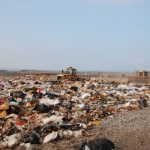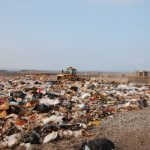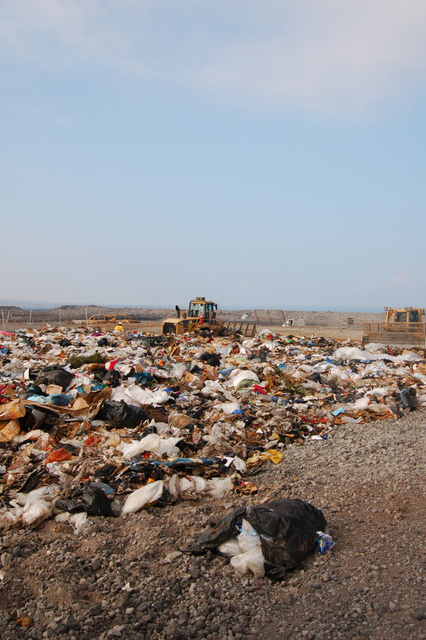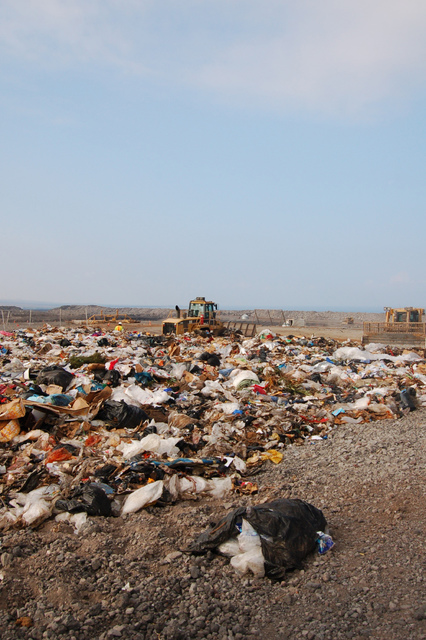A company owned by garbage hauler Pacific Waste Inc. is moving forward on long-held plans to build a waste conversion system in West Hawaii.
BioEnergy Hawaii LLC announced Thursday that it is negotiating for land near the West Hawaii Sanitary Landfill at Puuanahulu for a resource recovery site. The facility, planned for construction in 2016, would convert rubbish to recyclable commodities, organics and solid fuel.
The $50 million facility, which would be financed with private equity, is supported by a $100 million special purpose revenue bond issued by the State of Hawaii.
In addition to removing recyclables and selling them on the commodities market, organizers plan to convert wet organic waste such as food and green waste into fertilizer and high-quality compost using an anaerobic digestion process. The process will also create a biogas that can be used to generate electricity, be upgraded to renewable natural gas or compressed to create an alternative transportation fuel.
The residuals, such as mixed paper, textiles, low-value plastic and wood, would be processed into post-recycled engineered fuel brickets, which can be used for thermal energy conversion operations.
BioEnergy Hawaii plans to offer a lower tipping fee for local garbage haulers, thus competing with the county landfill that is run under a long-term contract by Waste Management Inc. If all goes as planned, as much as 70 percent of the waste could be diverted from the landfill, Guy Kaniho, BioEnergy Hawaii general manager, told West Hawaii Today.
“We believe this project will meet Mayor Billy Kenoi’s goal of extending the life of the county’s landfills by diverting more waste, and the joint goal of protecting the aina,” he said in a statement.
Kaniho said he’s spoken with county officials and believes the project could proceed with an environmental assessment, rather than a full-blown environmental impact statement. Kaniho said the county was receptive to the project, which won’t use taxpayer money.
Kenoi in January canceled a request for proposals from companies planning a waste-to-energy incinerator, saying low oil prices made the project financially unfeasible.
But a 70 percent diversion rate from the West Hawaii landfill could breach “put-or-pay” provisions in the contract, ultimately costing county taxpayers more. That gap could, in theory, be filled by transporting more East Hawaii garbage, a politically unpopular move that could, however, prolong the remaining life of the Hilo landfill.
Kenoi said Thursday that the project faces a number of federal and state regulatory hurdles. There will also be county permitting and land-use procedures, he said.
“We wish them well in their endeavors, and if they are able to finance and produce a clean, safe waste conversion system that provides benefit to the community and is sensitive to our environment, our culture and our community, then we support that,” he said.
The company plans a “closed-loop” waste recovery operation by encouraging local haulers to convert waste collection vehicles to use the biofuel produced by the facility. That would stabilize the waste hauler’s long-term fuel costs and reduce the island’s dependency on imported fossil fuels.
Incoming waste would be handled and processed in an enclosed building to ensure dust and odor control. The waste will be separated and sorted through a combination of automated and manual recovery methods.
“Given our island’s limited land area and fresh water resources,” said Kaniho, “recycling and waste diversion is a priority.”
BioEnergy Hawaii was formed in 2006 for the express purpose of establishing sustainable resource management operations in Hawaii. A 2008 partnership with the Natural Energy Laboratory of Hawaii Authority to create a waste-to-electricity plant didn’t work out, but the company has been able to keep its revenue bond over the administration of three governors.









